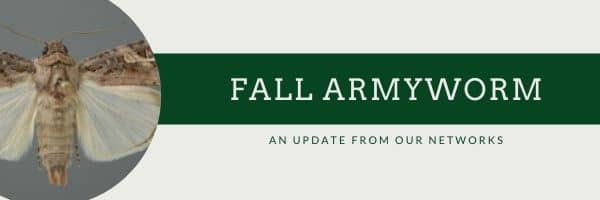Fall armyworm was first detected on two Torres Strait islands in January 2020 and confirmed in early February 2020. The first mainland detection in Australia was at Bamaga in February 2020.
Subsequent detections of fall armyworm have occurred: near Croydon, South Johnstone, Tolga, Lakeland, Mareeba, the Burdekin region and Bowen in North Queensland.
Fall armyworm has also been found in the Northern Territory (Katherine) and Western Australia (Kununurra).
The latest detection is in Bundaberg.
MEDIA RELEASE
Monday 6th April 2020 – For immediate release
Exotic pest fall armyworm detected in BundabergThe exotic pest fall armyworm (Spodoptera frugiperda) originally detected in the Torres Strait islands in January of this year has now been detected in the Bundaberg region.
Whilst this finding is not unexpected given the pests’ high mobile activity Bundaberg Fruit and Vegetable Growers (BFVG) Managing Director Bree Grima says this detection is cause for concern for the thriving agricultural industry. “This exotic pest has a huge appetite from citrus, mango, melon, sweet corn and cucurbits through to sugar cane” Ms Grima said. “It’s important to recognise not all crops are affected equally, melons for example do not appear to suffer from crop loss however it is expected that sweetcorn will be most susceptible to damage” said Ms Grima.
Fall armyworm is a new pest to Australia and the full extent of its preferred host plants is not yet fully understood and potential damage to field grown crops is unclear.
Fact sheets for affected commodities can be found on the Department of Agriculture website and the APVMA has issued certain chemical permits for fall armyworm on the permit portal here.
“Early detection and an integrated pest management approach is essential” said Ms Grima. Fall armyworm can cause significant crop damage depending on the host plant, growers and agronomists are therefore encouraged to regularly check their crops for unusual pest activity. Symptoms of activity can include leaf damage including pinholes and defoliation in addition to small larvae.
Growers are highly encouraged to photograph, and report suspect sightings to the Department of Agriculture and Fisheries on 13 25 23 or by contacting their local biosecurity officer.
END
For comment contact BFVG Managing Director Bree Grima 0403 616 702
Target Crops
Based on overseas experience, fall armyworm larvae can cause significant crop damage if left unchecked.
Adults can fly long distances and migrate quickly, particularly with the aid of weather patterns and jet streams. It is important to check crops regularly to detect the early stages of infestation.
- Cotton
- Maize
- Sorghum
- Sugarcane
- Sweet Corn
- Vegetables
WheatFall armyworm can infest vegetable crops including capsicum, chilli, tomato, pumpkins, cucumber, beans, eggplant and other vegetables.
Factsheets
QLD fall armyworm crop resources >>
What to look for
To help identify symptoms of fall armyworm, examine plants for:
- leaf damage, including pinholes, windowing, tattered leaf margins and defoliation of plants
- tiny larvae, less than 1mm, that are more active at night, eating pinholes and transparent windows in leaves
- bigger larvae grazing on leaves, stems, trunk and fruit, and leaving behind insect frass (droppings)
- in monocots, larvae are often in plant whorls (where leaves radiate from or wrap around the stem or stalk (see image 2)
- regular crop monitoring is essential to avoid undetected crops damage.If you suspect fall armyworm, report immediately to the Department of Agriculture and Fisheries on 13 25 23.
If you suspect fall armyworm, report immediately to the Department of Agriculture and Fisheries on 13 25 23.
Emergency minor use permits
| Permit ID | Description | Date Issued | Exp Date | Permit Holder | LINK |
| PER89241 | Spinetoram (Success Neo or Delegate)/ Fall armyworm/various crops | 6/03/20 | 31/03/23 | Hort Innovation | PERMIT |
| PER89259 | Chlorantraniliprole (Coragen, altacor and altacor hort insecticide labels)/ Fall armyworm/various crops | 6/03/20 | 31/03/23 | Hort Innovation | PERMIT |
| PER89263 | Emamectin (Proclaim opti insecticide)/Fall armyworm.various crops | 10/03/20 | 31/03/23 | Hort Innovation | PERMIT |
| PER89280 | Chlorantraniliprole + Thiamethoxam Durivo insecticide/ Fall armyworm/ various crops as per the registered Durivo label | 12/03/20 | 31/03/23 | Hort Innovation | PERMIT |
| PER89278 | Indoxacarb (Avatar insecticide)/Fall armyworm/various crops | 13/03/20 | 31/03/23 | Hort Innovation | PERMIT |
| PER89281 | Chlorantraniliprole (Coragen or Altacor hort insecticide)/Fall armyworm/Blueberries and avocados | 13/03/20 | 31/03/23 | Hort Innovation | PERMIT |
| PER89286 | Indoxacarb (Provaunt turf insecticide)/Fall armyworm/Turf production | 13/03/20 | 31/03/23 | Hort Innovation | PERMIT |
| PER89284 | Spinetoram (Success neo snsecticide)/Fall armyworm/Leek, spring onion, shallot and galangal | 16/03/20 | 31/03/23 | Hort Innovation | PERMIT |
| PER89285 | Emamectin (Proclaim opti snecticide)/Fall armyworm/ celery (field) brassica leafy vegetables, leafy beets, silverbeet and spinach (protected cropping), blueberries (field and protected cropping) | 16/03/20 | 31/03/20 | Hort Innovation | PERMIT |
| PER89290 | Chlorantraniliprole (Acelepryn turf insecticide)/Fall armyworm/Turf production | 17/03/20 | 31/03/20 | Hort Innovation | PERMIT |
| PER89279 | Various products/various crops/Fall armyworm | 11/03/20 | 31/03/23 | Plant Health Aust. | PERMIT |
Stay Updated
OTHER WEBSITES AND CONTACTS
- Queensland Government
- * Be alert and report signs to 13 25 23
- Farm biosecurity
- Horticulture Innovation Australia
- Management of Fall Armyworm WEBINAR
- Fall armyworm identification Dr Mark Schutze – https://youtu.be/E8UVsptz8l8
- Fall armyworm – surveillance and monitoring Rosalie Banks – https://youtu.be/-v4Q8Pw-ZJ0
- Fall armyworm – the essentials! Melina Miles – https://youtu.be/i-uYhVwfOTA
- GRDC fall armyworm podcast LIVE


Recent Comments